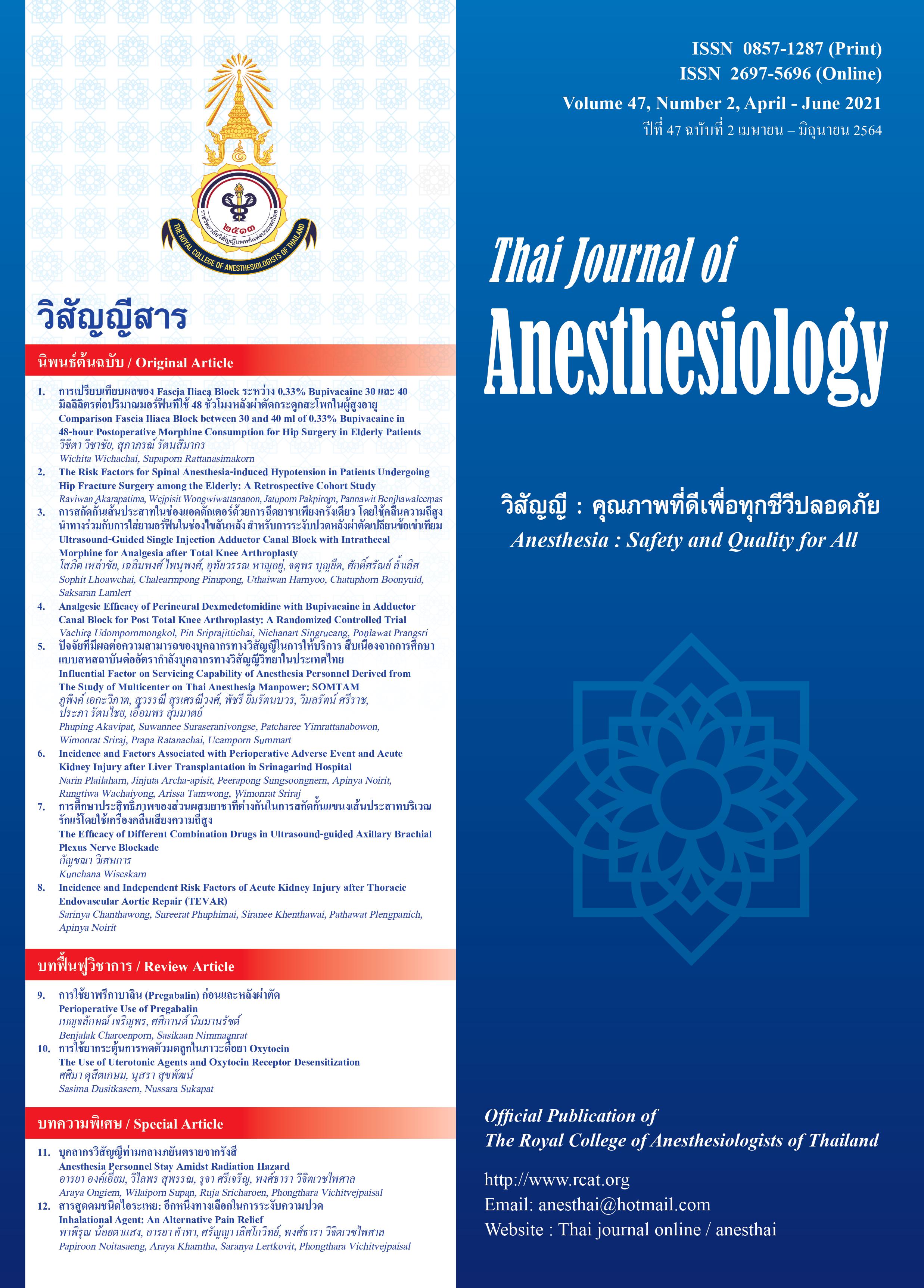Incidence and Independent Risk Factors of Acute Kidney Injury after Thoracic Endovascular Aortic Repair (TEVAR)
Main Article Content
Abstract
Introduction: Acute kidney injury (AKI) significantly increases morbidities and mortality rate and associate with poor outcome after endovascular procedures. Recognition of the incidence and risk factors of AKI is important. This study investigates the incidence, independent risk factors of AKI after thoracic endovascular aortic repair (TEVAR). Methods: We retrospectively reviewed patients who underwent TEVAR diagnosed AKI by RIFLE criteria in Khon Kaen University. The incidence of AKI and outcomes were collected. The risk factors of AKI were identified and analyzed. Results: The total 94 patients, 8 (8.5%) developed AKI after TEVAR. The patient with AKI had higher percentage of preexisting renal failure, blood loss, and packed red cell use [(62.50% vs. 19.77%, p = 0.016), (1508.75±1928.33 vs. 389.16±505.64 mL, p < 0.001), (5.0±3.35 vs. 2.64±1.6 unit, p =0.011), respectively]. Postoperative serum creatinine in patients with AKI was significantly higher (3.14±2.04 vs. 1.17±0.66 mg/dL, p <0.001). Intensive care unit (ICU) and hospital length of stay were increasing in patients with AKI (6.97±7.58 vs. 3.13±2.28 day, p = 0.001 and 27.38±27.30 vs. 14.20±10.90 day, p = 0.007, respectively). Logistic regression analysis, history of preexisting renal failure was independent risk factors for AKI after TEVAR [Adjusted Odds ratio (95% CI) 5.68 (1.01-32.18), p = 0.046]. Conclusions: Acute kidney injury after thoracic endovascular aortic repair is uncommon. Preoperative preexisting renal failure was identified as an independent risk factor of acute kidney injury.
Article Details
References
kidney injury after thoracic endovascular aortic repair.
Korean J Thorac Cardiovasc Surg 2016;49:15-21.
2. Pisimisis GT, Khoynezhad A, Bashir K, Kruse MJ, Donayre
CE, White RA. Incidence and risk factors of renal dysfunction
after thoracic endovascular aortic repair. J Thorac Cardiovasc
Surg 2010;140 (Suppl 6):S161-7.
3. Luo S, Ding H, Luo J, et al. Risk factors and early outcomes
of acute renal injury after thoracic aortic endograft repair
for type B aortic dissection. Ther Clin Risk Manag 2017;13:
1023-9.
4. Drews JD, Patel HJ, Williams DM, Dasika NL, Deeb GM. The
impact of acute renal failure on early and late outcomes after
thoracic aortic endovascular repair. Ann Thorac Surg 2014;
97:2027-33.
5. Martin-Gonzalez T, Pincon C, Maurel B, et al. Renal outcomes
following fenestrated and branched endografting. Eur J Vasc
Endovasc Surg 2015;50:420-30.
6. Van Biesen W, Vanholder R, Lameire N. Defining acute renal
failure: RIFLE and beyond. Clin J Am Soc Nephro 2006;
1:1314-9.
7. Piffaretti G, Mariscalco G, Bonardelli S, et al. Predictors and
outcomes of acute kidney injury after thoracic aortic
endograft repair. J Vasc Surg 2012;56:1527-34.
8. Zhu JC, Chen SL, Jin GZ, et al. Acute renal injury after
thoracic endovascular aortic repair of Stanford type B aortic
dissection: incidence, risk factors, and prognosis. J Formos
Med Assoc 2014;113:612-9.
9. Bagshaw SM, George C, Bellomo R, Committe ADM. A
comparison of the RIFLE and AKIN criteria for acute kidney
injury in critically ill patients. Nephrol Dial Transplant 2008;
23:1569-74.
10. Lopes JA, Fernandes P, Jorge S, et al. Acute kidney injury
in intensive care unit patients: a comparison between the
RIFLE and the Acute Kidney Injury Network classifications.
Crit Care 2008;12:R110.
11. Pisitsak C, Chittawatanarat K, Wacharasint P, Chaiwat O,
Komonhirun R, Morakul S. Prevalence, outcomes and risk
factors of acute kidney injury in surgical intensive care unit:
a multi-center Thai University-based surgical intensive care
units study (THAI-SICU Study). J Med Assoc Thai 2016;99
(Suppl 6):S193-S200.
12. Chinsakchai K, Phetpoonpipat W, Ruangsetakit C, et al.
Outcomes of asymptomatic abdominal aortic aneurysm as
compared between open aortic repair and endovascular
aneurysm repair. J Med Assoc Thai 2017;100: (Suppl
2):S162-S9.
13. Ehrlich MP, Dumfarth J, Schoder M, et al. Midterm results
after endovascular treatment of acute, complicated type B
aortic dissection. Ann Thorac Surg 2010;90:1444-8.
14. Zeeshan A, Woo EY, Bavaria JE, et al. Thoracic endovascular
aortic repair for acute complicated type B aortic dissection:
superiority relative to conventional open surgical and medical
therapy. J Thorac Cardiovasc Surg 2010;140 (Suppl 6):S109-15.
15. De Rango P, Estrera A. Uncomplicated type B dissection:
are there any indications for early intervention?. J Cardiovasc
Surg (Torino) 2011;52:519-528.
16. Patel HJ, Sood V, Williams DM, Dasika NL, Diener AC, Deeb
GM. Late outcomes with repair of penetrating thoracic aortic
ulcers: the merits of an endovascular approach. Ann Thorac
Surg 2012;94:516-22.
17. Ren HM, Wang X, Hu CY, et al. Relationship between acute
kidney injury before thoracic endovascular aneurysm repair
and in-hospital outcomes in patients with type B acute aortic
dissection. J Geriatr Cardiol 2015;12:232-238.
18. Rizvi AZ, Sullivan TM. Incidence, prevention, and management
in spinal cord protection during TEVAR. J Vasc Surg 2010;52
(Suppl 4):86S-90S.
19. Bobadilla JL, Wynn M, Tefera G, Acher CW. Low incidence
of paraplegia after thoracic endovascular aneurysm repair
with proactive spinal cord protective protocols. J Vasc Surg
2013;57:1537-42.


